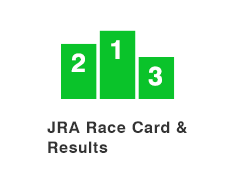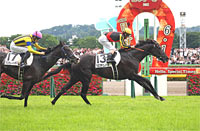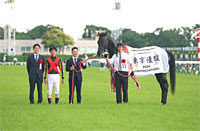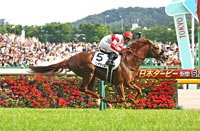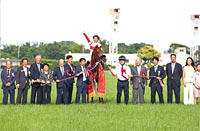Tokyo Yushun (Japanese Derby) (G1) - Data Analysis
The race of a lifetime that attracts nationwide attention
The Tokyo Yushun (Japanese Derby) is the ultimate showdown for three-year-olds. It has been held consistently since its establishment in 1932, with the only interruption occurring during the turmoil of the war and postwar period. Which runner will claim the title of 92nd Japanese Derby horse? We analyzed the relevant data, focusing on the results over the last 10 years.
As a basic rule of thumb, watch runners backed as 5th favorite or higher
Looking at performances by runners over the last 10 years in terms of favoritism, we find a major discrepancy in Top 2 ratios between runners backed as 5th favorite or higher and those backed as 6th favorite or lower. Runners backed as 5th favorite or higher have occupied the Top 2 in eight of the last 10 years. While race favorites have historically performed well, we should mention that they have only produced two winners over the last 10 years, and therefore have struggled to come out on top. [Table 1]
[Table 1] Performance by favoritism (last 10 years)
| Favoritism |
Performance
[1st-2nd-3rd-4th or lower] |
Win ratio |
Top 2 ratio |
Top 3 ratio |
| 1st favorite |
2-3-2-3 |
20.0% |
50.0% |
70.0% |
| 2nd favorite |
1-3-1-5 |
10.0% |
40.0% |
50.0% |
| 3rd favorite |
2-2-1-5 |
20.0% |
40.0% |
50.0% |
| 4th favorite |
2-1-0-7 |
20.0% |
30.0% |
30.0% |
| 5th favorite |
1-1-0-8 |
10.0% |
20.0% |
20.0% |
| 6th favorite or lower |
2-0-6-120 |
1.6% |
1.6% |
6.3% |
Runners that have finished in the Top 3 of the Satsuki Sho are strong contenders
In the Japanese Derby over the last 10 years, the 30 Top 3 finishers had all come from one of the following races: Satsuki Sho (Japanese 2000 Guineas), Kyoto Shimbun Hai, Mainichi Hai, Keisei Hai, TV Tokyo Hai Aoba Sho (Japanese Derby Trial), or the Principal Stakes. Among the Top 3 finishers, runners coming from the Satsuki Sho achieved performance of [5-8-3-13], with a Top 3 ratio of over 50%. This suggests that standout performers in the Satsuki Sho should be our starting point when building predictions. [Table 2]
[Table 2] Performance by previous race (last 10 years)
| Previous race |
Performance
[1st-2nd-3rd-4th or lower] |
Win ratio |
Top 2 ratio |
Top 3 ratio |
| Satsuki Sho (Japanese 2000 Guineas) |
7-9-7-74 |
7.2% |
16.5% |
23.7% |
| Kyoto Shimbun Hai |
1-1-0-15 |
5.9% |
11.8% |
11.8% |
| Mainichi Hai |
1-0-0-7 |
12.5% |
12.5% |
12.5% |
| Keisei Hai |
1-0-0-0 |
100% |
100% |
100% |
| TV Tokyo Hai Aoba Sho (Japanese Derby Trial) |
0-0-2-19 |
0% |
0% |
9.5% |
| Principal Stakes |
0-0-1-8 |
0% |
0% |
11.1% |
| Other race |
0-0-0-25 |
0% |
0% |
0% |
Finish in the Top 8 last time out is key selection criterion
In the Japanese Derby over the last 10 years, 23 of the 30 Top 3 finishers had finished in the Top 3 of their previous race. Conversely, there have been few examples of rebound performances by runners that had been beaten to 6th or lower in their previous race. In particular, the 42 runners that had finished 9th or lower in their previous race did not produce a single Top 3 finisher. The data therefore suggest we should lower our expectations of those runners. [Table 3]
[Table 3] Performance by finish in previous race (last 10 years)
| Finish in previous race |
Performance
[1st-2nd-3rd-4th or lower] |
Win ratio |
Top 2 ratio |
Top 3 ratio |
| 1st |
4-5-3-34 |
8.7% |
19.6% |
26.1% |
| 2nd, 3rd |
4-4-3-34 |
8.9% |
17.8% |
24.4% |
| 4th, 5th |
1-0-2-18 |
4.8% |
4.8% |
14.3% |
| 6th-8th |
1-1-2-20 |
4.2% |
8.3% |
16.7% |
| 9th or lower |
0-0-0-42 |
0% |
0% |
0% |
Note: Pulled up horses are included under “9th or lower.”
Focus on runners with 5 or fewer career starts
In the Japanese Derby over the last 10 years, there has been a clear disparity in performance between runners with 5 or fewer career starts and those with 6 or more career starts. In particular, runners with 6 career starts or more and backed as 8th favorite or lower delivered performance of [0-0-0-52], with no record of success. In other words, we can exclude such horses from our shortlist. [Table 4]
[Table 4] Performance by total career starts (last 10 years)
| Total career starts |
Performance
[1st-2nd-3rd-4th or lower] |
Win ratio |
Top 2 ratio |
Top 3 ratio |
| 5 or fewer |
10-9-7-84 |
9.1% |
17.3% |
23.6% |
| 6 or more |
0-1-3-64 |
0% |
1.5% |
5.9% |
Seek out the winner!
Derby winners come from sires with proven form in the Japanese Derby
The sires of the last 10 winners had all finished in the Top 3 of the Japanese Derby during their racing days. The main sires with progeny among the current crop of three-year-olds and a prior finish in the Top 3 of the Japanese Derby are Epiphaneia, Kizuna, Rey de Oro, Duramente, Orfevre, Isla Bonita, Suave Richard, Satono Crown, and Roger Barows. We should therefore keep a close eye on the colts and fillies of these sires. [Table 5]
[Table 5] Sires of winners and their finish in the Japanese Derby (last 10 years)
| Year |
Winner |
Sire (finish in the Japanese Derby) |
| 2015 |
Duramente |
King Kamehameha (1st) |
| 2016 |
Makahiki |
Deep Impact (1st) |
| 2017 |
Rey de Oro |
King Kamehameha (1st) |
| 2018 |
Wagnerian |
Deep Impact (1st) |
| 2019 |
Roger Barows |
Deep Impact (1st) |
| 2020 |
Contrail |
Deep Impact (1st) |
| 2021 |
Shahryar |
Deep Impact (1st) |
| 2022 |
Do Deuce |
Heart’s Cry (2nd) |
| 2023 |
Tastiera |
Satono Crown (3rd) |
| 2024 |
Danon Decile |
Epiphaneia (2nd) |
(Yodohito Himezono)
|








